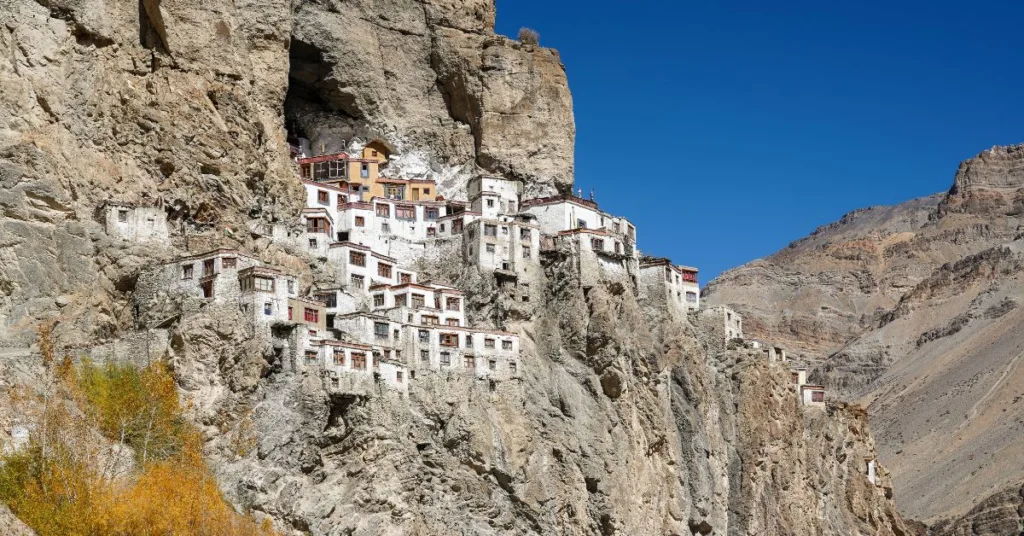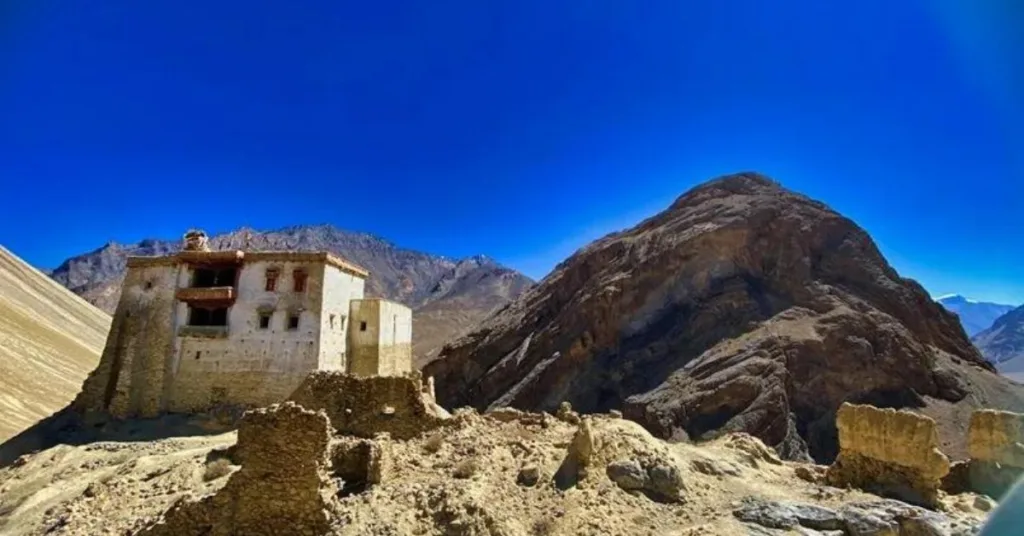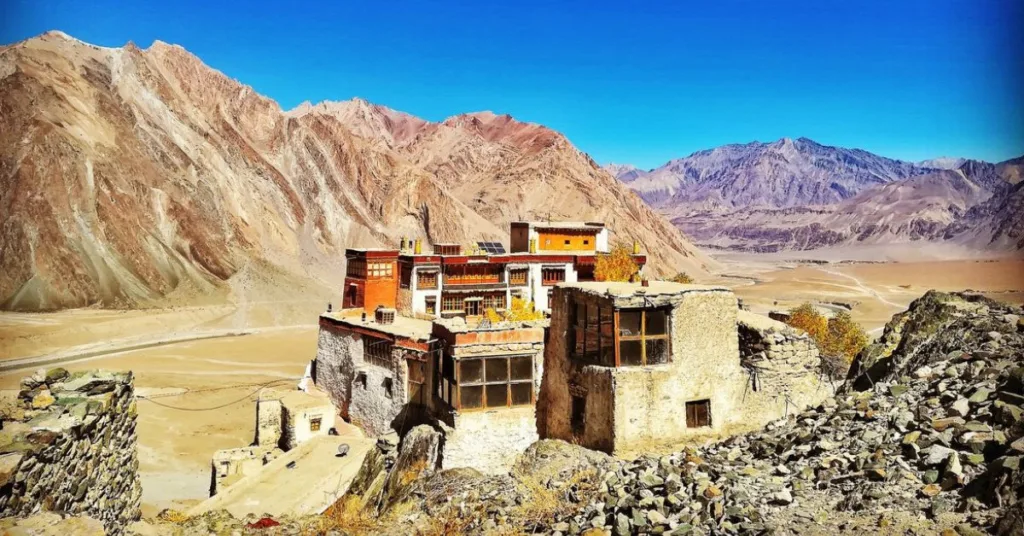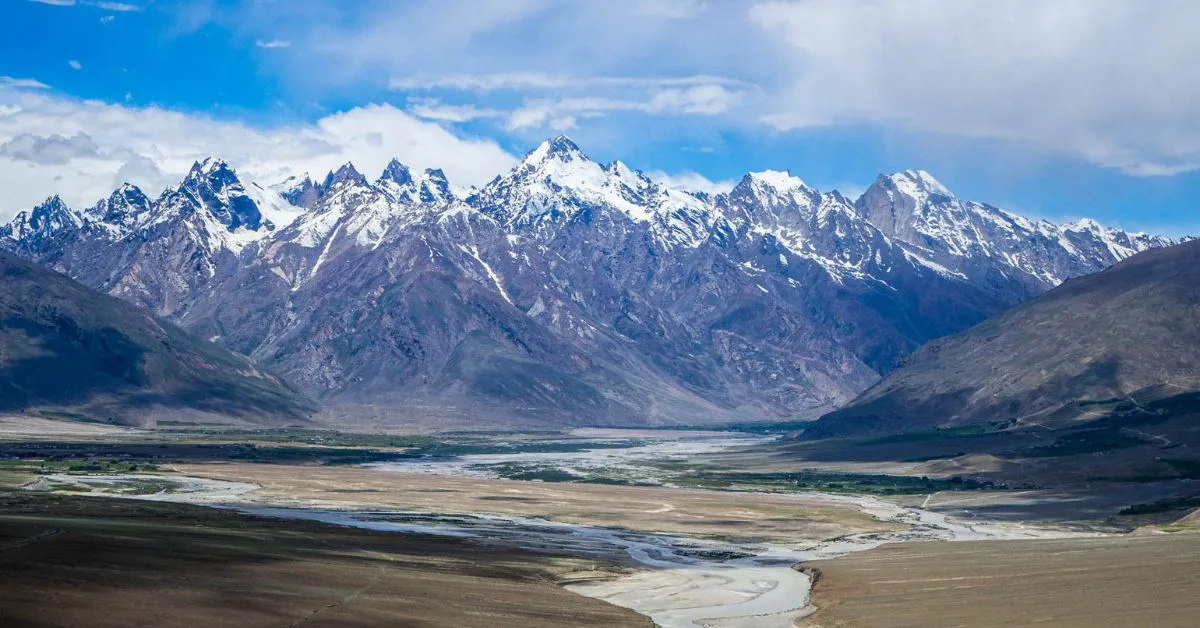Zanskar Valley is a hidden treasure in the heart of Ladakh. It’s a place of tall mountains, old monasteries, and peaceful beauty. People often call it “Little Tibet” because it feels like a quiet escape from the busy world.
Surrounded by big, snowy peaks, Zanskar is perfect for people who love adventure, nature, or finding peace. It’s not just the amazing views that make it special, but also the rich culture and history. There are lots of old monasteries, like the famous Phugtal Monastery, built right into the cliffs.
How to reach:
By Air:
The closest airport to Zanskar is in Leh, Ladakh. You can fly there from major Indian cities. However, there are no direct flights to Zanskar. You’ll need to continue your journey by road or trek.
By Road:
Most people travel to Zanskar by road. Here’s how:
- From Leh: You’ll drive on the Leh-Srinagar highway and then turn towards Zanskar. The journey takes about 12-15 hours through stunning landscapes.
- From Kargil: This is a shorter route, taking about 7-9 hours.
Important: The road to Zanskar is only open from late June to early September due to snow. Check road conditions before you go.
By Trek:
For adventurous travelers, there are trekking options:
- Chadar Trek: This famous trek follows the frozen Zanskar River in winter. It’s challenging but rewarding.
- Other Treks: There are other trekking routes from Leh and Kargil that lead to Zanskar, offering beautiful views.
Best time to visit:
Summer (June to September)
Summer is the best time to explore Zanskar. It’s pleasantly warm, with temperatures around 15-25°C. The roads are open, making travel easy. You can enjoy trekking, visiting monasteries, and experiencing local festivals.
Winter (December to February)
Zanskar turns into a winter wonderland with freezing temperatures and heavy snow. This is the time for the famous Chadar Trek, where you walk on the frozen Zanskar River. Be prepared for extreme cold and limited access, as the roads are closed.
Spring (March to May)
Spring brings warmer weather, but it can still be cold, especially at higher altitudes. The snow starts to melt, revealing beautiful landscapes. Roads are opening, but conditions might be rough.
Autumn (October to November)
Autumn offers cool, clear weather, perfect for trekking and exploring. The crowds are smaller than in summer. Roads are usually good, but winter is approaching.
Attractions:
Phugtal Monastery:

Phugtal Monastery is a magical place built into a cliff in a faraway part of Zanskar Valley. It’s like something from a storybook. This special monastery was built a long time ago by a very smart and holy person. The monastery looks like it’s growing out of the cliff, with amazing views of the wild mountains around it.
Getting there is a big adventure, but it’s worth it. Inside, you’ll find beautiful old paintings and important religious books. The monastery feels very peaceful, and it’s easy to understand why people come here to learn and find peace. It’s a place where you can feel close to nature and spirituality at the same time.
Zangla Village:
Zangla is a pretty village on the edge of Zanskar Valley. It’s surrounded by tall mountains and green fields, and it feels like a real Ladakhi village. The houses are old and made from local materials, with beautiful wooden decorations. There’s also an old monastery in Zangla with special books and things from the past. It’s one of the last villages in the valley, so it’s a great place to see how people really live in Zanskar.

Stongdey Monastery:

Stongdey Monastery is a big and important place for Buddhist people in Zanskar. It’s very old and sits high on a hill with amazing views of the valley. Inside, you’ll find beautiful paintings, old books, and special pictures that tell stories about Buddhism. There are special festivals here with traditional Ladakhi dances and prayers. It’s a peaceful place with a long history, perfect for learning about Buddhism and the local culture.
Local Experiences:
- Taste local flavors: Enjoy delicious Ladakhi food like momos, thukpa, and skyu.
- Experience local culture: Watch colorful festivals and traditional dances at monasteries.
- Immerse yourself in local life: Stay with local families to understand their way of life.
- Explore the great outdoors: Go trekking or hiking through stunning landscapes.
- Learn new skills: Try thangka painting or weaving workshops.
- Discover spirituality: Attend religious ceremonies at monasteries.
- Shop for souvenirs: Find unique handicrafts at local markets.
- Capture the beauty: Join photography tours to capture amazing pictures.
- Unique adventures: Take a yak safari or enjoy peaceful nature walks.
- Immerse in local arts: Experience traditional Ladakhi music and dance.
- Learn about Buddhism: Interact with monks and learn about their way of life.
Travel tips:
- Get the right permits: You’ll need an Inner Line Permit (ILP) to visit Zanskar.
- Acclimatize: Spend some time in Leh to adjust to the high altitude.
- Get travel insurance: Make sure you have good insurance that covers high altitudes.
- Pack for all weather: You’ll need clothes for both warm and cold weather.
- Bring necessary medicine: Pack a first aid kit with medicine for altitude sickness and other issues.
- Bring cash: There might not be many places to use your card.
- Check road conditions: Make sure the roads are safe before you travel.
- Respect local people: Dress modestly and ask permission before taking photos.
- Be prepared for limited phone service: Don’t rely on your phone to work.
- Drink plenty of water: Stay hydrated to feel better at high altitude.
- Protect the environment: Don’t litter and take care of the beautiful landscape.
- Hire a local guide: Learn more about the area and support the local community.
Conclusion
Zanskar Valley is a hidden gem nestled in the heart of Ladakh, offering a unique blend of rugged landscapes, rich cultural heritage, and spiritual tranquility. From the awe-inspiring Phugtal Monastery perched dramatically on a cliff to the serene Tso Moriri Lake surrounded by snow-capped peaks, the valley unveils a tapestry of breathtaking vistas. Immerse yourself in the vibrant local culture through traditional festivals, homestays, and delectable cuisine. Whether you’re an intrepid explorer seeking challenging treks or a spiritual seeker drawn to ancient monasteries, Zanskar offers an unforgettable journey. Experience the warmth of local hospitality, witness the stark beauty of the landscape, and gain a profound understanding of the Ladakhi way of life.
FAQs
1. What is the ideal time to visit Zanskar Valley?
- The optimal time to visit Zanskar Valley is between June and September when the weather is favorable and roads are open. For those interested in winter adventures like the Chadar Trek, the period from December to February is ideal, but prepare for extremely cold temperatures and challenging conditions.
2. How do I obtain permits to visit Zanskar Valley?
- To visit Zanskar Valley, you need an Inner Line Permit (ILP), which can be acquired through a travel agency in Leh or directly from the District Magistrate’s Office in Leh. It’s best to arrange this in advance to ensure smooth travel.
3. What types of accommodations are available in Zanskar Valley?
- Accommodation options in Zanskar Valley include basic guesthouses and lodges in towns like Padum, as well as traditional homestays in remote villages. It’s advisable to book in advance, especially during the peak tourist season.
4. What are the main attractions in Zanskar Valley?
- Key attractions in Zanskar Valley include Phugtal Monastery, Zangla Village, Stongdey Monastery, Suru Valley, Padum, Lamayuru Monastery, Zanskar River, Yurutse Village, Korzok Monastery, and Tso Moriri Lake.
5. Is traveling to Zanskar Valley safe?
- Traveling to Zanskar Valley is generally safe, but it requires proper preparation due to its remote and high-altitude nature. Ensure you are acclimatized, travel with a reputable guide, and follow safety recommendations.
6. What should I pack for a trip to Zanskar Valley?
- Pack clothing suitable for a range of temperatures, including thermal layers, a down jacket, gloves, and a hat. Sturdy trekking boots, sun protection (sunglasses, sunscreen), a first-aid kit, and high-altitude medications are also essential.
7. How can I get to Zanskar Valley?
- The main gateway to Zanskar Valley is Leh, accessible by air from major cities in India. From Leh, you can travel to Zanskar by road (typically from June to September) or by trekking routes during the winter months.
8. What health precautions should I take before traveling to Zanskar?
- To prevent altitude sickness, acclimatize by spending a few days in Leh before heading to Zanskar. Carry altitude sickness medications, a basic medical kit, and consult a healthcare provider before your trip.
9. Can I use credit or debit cards in Zanskar Valley?
- Credit and debit card facilities are limited in Zanskar Valley. It is advisable to carry enough cash to cover all expenses and transactions.
10. What activities can I enjoy in Zanskar Valley?
- Activities in Zanskar Valley include trekking (such as the Markha Valley Trek and Chadar Trek), exploring monasteries, participating in local festivals, photography, and visiting scenic locations like Tso Moriri Lake.
11. Is mobile network coverage available in Zanskar Valley?
- Mobile network coverage in Zanskar Valley is sparse. You may find network services in Padum and other major towns, but coverage can be limited in remote areas.
12. What cultural etiquette should I follow in Zanskar Valley?
- Dress modestly, particularly when visiting religious sites. Always ask for permission before taking photos of people or religious artifacts. Respect local customs and engage with the community in a considerate manner.






